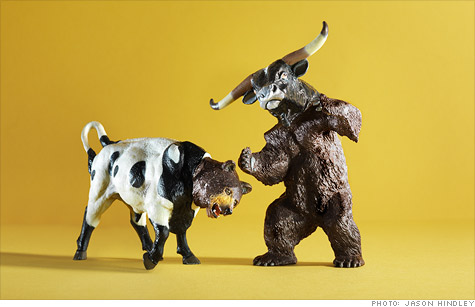
After a mercurial run-up for stocks, Wall Street is back to the age-old debate of a bull vs bear market.
(MONEY Magazine) -- Labels like "bull" or "bear" market have mattered little lately. All you needed to know was, "Should I put on my aggressive or defensive hat today?"
As views of the recovery shifted on a seemingly daily basis throughout much of 2011, investors pingponged back and forth from being uniformly optimistic to unanimously pessimistic. That is, until a spate of good news sent stocks steadily up 30% since October.
Is this a real bull, or just a bullish façade that belies the market's true bearish form? To find out, MONEY turned to some of the market's smartest thinkers.
The improving outlook abroad: Liz Ann Sonders, chief investment strategist at Charles Schwab, acknowledges that Europe isn't out of the woods. But "a Lehman-style collapse is off the table," she says, now that Europe's bailout fund is coming to Greece's aid again.
Meanwhile, University of Pennsylvania professor Jeremy Siegel, the dean of the permabulls, argues that the other big worry overseas -- the slowdown in China's economic growth -- is overblown. This is all part of the country's five-year plan.
"I'm optimistic China's landing will be bumpy but not hard," says Siegel, who expects 6% to 7% growth there this year and 9% to 10% after that.
The recovery at home: Sonders says two big soft spots -- housing and jobs -- are on the mend. And Wally Weitz, manager of the Weitz Hickory Fund, which is in the MONEY 70, points out that the recovery only needs to step up modestly.
"If the economy grows a couple of percent, if housing picks up to mediocre from poor, if Europe has a recession but climbs out, and if emerging markets stay dynamic, that all adds up to something positive," he says.
The big picture: Siegel says that bull markets always "climb walls of worry." As the economy improves, though, and interest rates start to rise -- yields on 10-year Treasuries have jumped from 1.8% in January to 2.3% -- the bears will have to take notice.
The cloudy outlook abroad: Money manager John Hussman argues that while Europe appears to be stabilizing at the moment, policymakers there "have essentially wallpapered over their problems instead of fixing them."
And Rob Arnott, chairman of Research Affiliates, notes that the big problem facing troubled countries such as Greece is that they're set up to run on borrowed money indefinitely, which could become unsustainable if austerity stifles economic growth. "They risk running headlong into their own brick wall," he says.
The false sense of security at home: Hussman says bulls may be confusing real trends with random fluctuations. The warm winter may have given a temporary boost to housing and jobs. Meanwhile, "leading economic indicators like growth in real consumption and income are still very soft," he says.
The bailout that bruised capitalism
The big picture: Bob Rodriguez, CEO of FPA and a longtime bear, says recent market gains are keeping attention off two lurking problems: easy money that's egging on spending, and the government's addiction to debt.
"If it continues to seem like we have no long-term fiscal controls, our foreign suppliers won't want to keep lending to us at such low rates," Rodriguez warns. Trying to solve this problem simply through massive spending cuts or tax hikes, though, could lead to a recession, Arnott says.
It's possible the bulls and bears are both right.
Yes, the market is in rally mode, and there's ample economic data to justify the S&P 500's 120% gains since March 2009.
The bears, however, are right to be skeptical about the strength and length of this run. History says there are two types of bull and bear markets -- run-of-the-mill cycles that drive stocks for a few years, in addition to epic stretches like the 1982-99 bull and the long-term bear that began in 2000.
Is this the start of another historic surge? Probably not.
The last time you saw one of those, the market's price/earnings ratio, based on 10 years of averaged earnings, stood at 7. Today it's at a higher-than-average 22. Most likely, this is a short-term bull that's good, but not great enough to shake the market's long-term malaise.
Bottom line: Expect modest gains -- or worse -- from here on out.
Do you know a Money Hero? MONEY magazine is celebrating people, both famous and unsung, who have done extraordinary work to improve others' financial well-being. Nominate your Money Hero. ![]()

Carlos Rodriguez is trying to rid himself of $15,000 in credit card debt, while paying his mortgage and saving for his son's college education.
| Overnight Avg Rate | Latest | Change | Last Week |
|---|---|---|---|
| 30 yr fixed | 3.80% | 3.88% | |
| 15 yr fixed | 3.20% | 3.23% | |
| 5/1 ARM | 3.84% | 3.88% | |
| 30 yr refi | 3.82% | 3.93% | |
| 15 yr refi | 3.20% | 3.23% |
Today's featured rates: